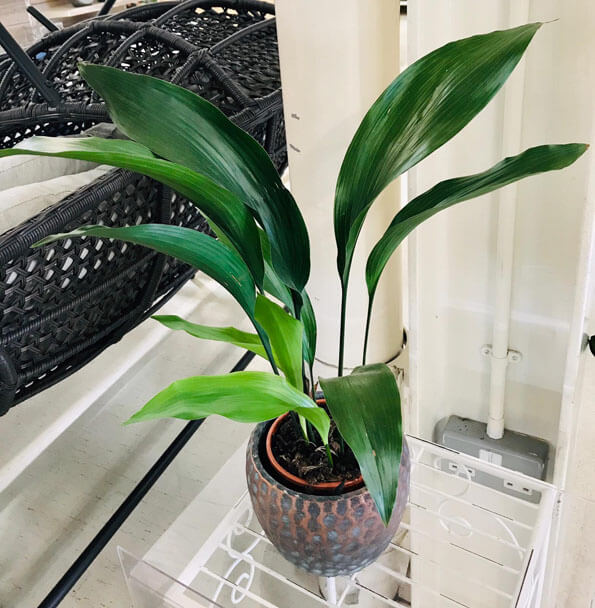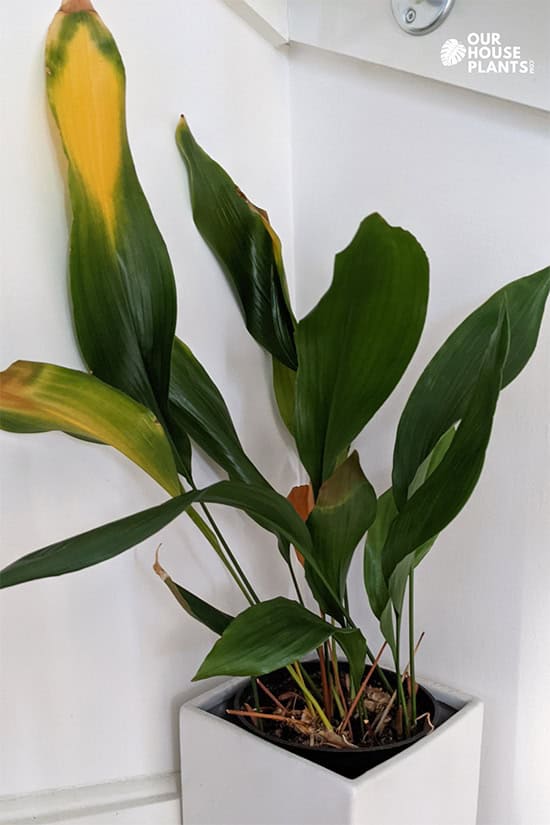Aspidistra elatior or the Cast Iron Plant belongs to the lily family and is native to China and Japan. Once a very popular houseplant, it was a common feature of many a Victorian hallway.
Although its popularity has faded slightly since this period and is now much less common in modern homes, it's still a wonderful indoor plant to own.
Although less common to see, an Aspidistra still makes for an elegant houseplant
The fall in popularity however is nothing to do with the plant being complicated or difficult. In fact, because it's fully capable of dealing with poor light, murky conditions as well as poor air quality, warm or cold temperatures it received its nickname: Cast Iron Plant for its near indestructibility.
It famously even appeared in the 1936 novel "Keep the Aspidistra Flying" by George Orwell (although the book itself has nothing to do with houseplant care!).
The large paddle shaped leaves are often a dark shade of green and growing slowly it produces only a few new leaves a year. The main advantage of this is that it won't outgrow the location you choose for it, for a good many years.
It will live quite happily in many areas of the home without too much effort from you.
The disadvantage of growing so slowly means it does take a long time to grow to a saleable size, therefore Aspidistra's can be very expensive to buy.
The cost, combined with some of the incorrect stereotypes that the plant is old fashioned and "fussy" in modern homes means it can be quite difficult to get hold of.
However, it's worth searching for, despite the stereotype it's actually a very forgiving and beautiful houseplant to grow. It will also live quite happily in many areas without too much effort from you. They also have incredible potential for longevity, with lots of anecdotal stories of peoples Aspidistra's reaching 50 years of age and beyond.
A large Aspidistra in a white pot
The most common variety of Aspidistra is the one with all green leaves, A. elatior (sometimes labeled as A. lurida). It's traditional, easy to care for and quite possibly the variety you're most likely to come across.
That said, there are some variegated varieties out there although they're harder to come across. Be prepared to seek out the specialist seller if you fall in love with variegated types and vow to yourself that you must own one.
Cost - These houseplants can be expensive. A full pot with more than 15 large leaves could easily cost $40 / £30 or more. If money is a factor look for smaller plants with fewer leaves. In time they will grow.
The variegated varieties are less forgiving about lighting requirements as they'll need more light to retain their stripes or markings. They can also be less hardy when it comes to temperature and are a little slower growing than their green cousin. The all green A. elatior is not a fast grower at the best of times, so a cultivar that is even slower may account for its lack of availability.
There are the speckled types like "Milky Way" (below), which have white speckles covering the leaves. Although they're the same plant, this variety can actually go by two names, Aspidistra vietnamensis 'Ginga' and Aspidistra elatior 'Milky Way'.
They're a little easier to look after than the all green variety and I really do love mine. Availability is quite limited and small plants with one or two leaves will be expensive and take a long time to grow into a full looking plant. But opting for a mature plant with multiple leaves will be pricey.
I'd say they should be thought of as "rare houseplants". Potentially the price will decrease in time, but I wrote the basics of this article almost 10 years ago and not much has changed since.
A large Aspidistra vietnamensis Milky Way indoor plant like this could be $100 / £80 or more.
Then you have the Aspidistras with stripes such as A. elatior Okame that have bold white markings. Whereas A. elatior variegata makes itself heard with its creamy white leaves, sometimes tinged with yellow or lime green.
Whether green or variegated, all Cast Iron Plants have the same care requirements in order to thrive. So read on for some photos, step-by-step care instructions, common plant problems as well as other reader's comments and owner's growing tips.

Hi, I'm Tom!
If you're like me and enjoy the challenge of growing houseplants and getting them to thrive, then Ourhouseplants can help. This website shares my knowledge and years of growing plants and provides (hopefully) helpful advice on properly caring for your indoor plant friends.
When it comes to the light requirements for an Aspidistra it's very easy to get right. Providing it isn't direct sunlight it can pretty much deal with any light it's given.
While forgiving generally, it won't survive sunshine (bright light is fine). So aim for a north facing window, or a shady / bright position deeper into a room with other facing aspects.
The Aspidistra's cast iron nature means it will deal with sporadic occasional watering easily and can work around dry soil.
This houseplant is not a cactus though, so to really thrive it does need a reasonable amount of water during the growing season, although you'll need to let it dry out between watering's.
Important - The soil should only ever be moist, never soaked or sodden. In the Winter months just enough is needed to keep it ticking over.
If you've chosen a dark or shady area for it to live, the need for water will be much less, so be careful not to overdo it as significant overwatering will cause problems (see "Cast Iron Plant leaves turning yellow" for more).
In low light locations and if the temperature is cooler in general, for example during Winter, it's unlikely you will need to water your plant more than once every two weeks. Perhaps even less. The rule to follow is that you only need to water your plant when the soil has almost fully dried out.
Humidity levels are not important for this plant. Dry or moist air, it can cope with it all, so go nuts.
Feed your plant during the growing season about once every two or three months with a normal strength houseplant feed solution. They're not heavy feeders so you won't need to do it more than this.
A temperature range between 7°C (45°F) - 29°C (85°F) is ideal so you won't typically need to worry about this in the average home. If growing outside, these plants can cope with temperatures down to about -10°C (14°F) given some protection.
Do expect some of the leaves to yellow up and go brown and I really wouldn't recommend taking the risk with Grandma's 50 year old plant! Bring them indoors when the temperature drops.
Photo showing the white speckled leaves of Aspidistra 'Milky Way' by Plantsorbust
You should only be repotting a Cast Iron Plant very occasionally. It strongly dislikes disturbance at its roots and like giving too much sun, frequent repotting will damage the plant.
For young plants you should not repot more than once a year and for a mature Aspidistra you're looking at doing it once every three or four years at the most. A pot slightly bigger than the current one and standard potting soil should be used.
I have a care guide on YouTube if you'd like to see more footage of my plants.
If you want to propagate your plant you can do this when you repot it by slowly and carefully dividing the "clump", you'll need to keep at least two or three stems in each division.
The roots are white and string like but they're easy to handle and are sturdy compared to other houseplants. However this can be misleading because they're sensitive and don't like being damaged.
If you decide to divide your plant it's best to try and do it by hand and untangle the roots as you go, rather than cutting through them using a spade or knife.
No matter what you do an Aspidistra will always grow quite slowly.
For example, mine tends to only put out three or four new light green leaves each Spring. These slowly grow bigger and change to the familiar darker green over the rest of that particular growing season.
New Cast Iron Plant leaves often emerge from the soil in Springtime
By the time September has arrived the new leaves from the Spring are indistinguishable from the older ones and that's the end of that year's growth cycle.
Once established and mature, the leaves do not change from year to year, although it's normal for older Aspidistra leaves to go yellow and die off each year.
The maximum height and spread for these plants is usually no more than 1m / 3ft at most. Realistically many plants will never reach that height and so 50cm / 1.5ft is pretty standard.
Yes you can get flowers on the Cast Iron Plant (see picture)! However, although quite rare, they're unremarkable and have no scent.
The flowers emerge out of the ground and stay at soil level, this is because they're (apparently) pollinated by slugs, snails and Amphipods out in their natural habitat. New research suggests they're actually pollinated mainly by Fungus Gnats (who knew these annoying pests could actually be useful for something!).
The purple Aspidistra Flowers are unusual for an indoor plant but not unheard of
It's normal to only get one flower at a time, and typically each one will last for a few weeks. Only mature plants will produce flowers and the light levels need to be reasonably good.
The beautiful Aspidistra plant has the added benefit of not being toxic to people, cats or dogs.
The large paddle leaves are true dust magnets. Although dusty leaves won't harm the plant, it can dull the look of your plant so, wash them every six months to keep them looking at their best.
Low to Moderate Light Levels An adaptable houseplant that will cope with any light level except total darkness or full sun.
Low to Moderate Watering Once a week at most. Water well and then wait until the soil has almost dried out before watering again.
Temperature Average room temperatures are ideal.
Feeding Feed once every two or three months.
The Aspidistra is a tolerant and hardy plant, it can stand dark hallways, cool temperatures and polluted air, but if you're having problems have a look below.
Brown tips on Aspidistra leaves
This can be difficult to diagnose as brown tips on the leaves can be caused by a variety of things. You'll need to read the below and relate it to your past care techniques to understand what's gone wrong. Meanwhile, you can cut the brown tips off without harming the leaves.
Brown edges / scorch marks
Aspidistra is a little like a vampire in the sense it doesn't need a great deal to live, but it absolutely can not stand bright sunlight. It needs a shady / bright location or the weak filtered sunlight from another aspect, anything more is too much.
Aspidistra leaves turning yellow
The odd leaf going yellow is normal and not something to be worried about. However if the leaves are going yellow on mass, or one at a time but over a long period this is a problem and is often caused by one of the following:
Possible Cure: The yellowing problem happened to my Aspidistra once before. Probably from too much water over Winter (we can all get it wrong sometimes!).
The odd leaf going yellow is normal and not something to be worried about
Sometimes individual stems do these things to try and allow the rest of the plant to survive and after one leaf went totally yellow it was like it sent a signal to another one to start yellowing up.
Starting from the center of the leaf, many leaves kept going yellow one by one in a cascade effect and after slowly losing seven large leaves within just a few weeks, things were becoming quite worrying.
Yellowing like this can be normal, but because there is so much of it happening at once this is clearly a problem that needs sorting out.
In the end I halted the yellowing by taking a radical approach by cutting off an entire leaf stem very close to the soil that had the very first signs of a yellow streak appearing. This seemed to stop the "signal cascade" and there was no more yellowing going forward.
It worked for me. If you have the same problem give it a go!
My houseplant collecting journey started many years ago. Fast forward a decade (almost two) and there are now only three plants that have been with me from the very beginning. A Dragon Tree, a Snake Plant and an Aspidistra. These are tough plants with a can do attitude.
Don't write Aspidistra off as old fashioned or difficult. They're not. And don't let anyone tell you otherwise.
Yeah we've had touch and go moments and some hairy points in our relationship, but it's never given up. These houseplants deserve every ounce of their reputation and the Cast Iron Plant nickname.
Don't write Aspidistras off as old fashioned or difficult. They're not. And don't let anyone tell you otherwise. They're tough and will perform for you without missing a beat. Whether you're an attentive owner or a more casual indoor gardener it won't step out of line and instead will do you proud (providing you at least semi stick to our instructions given above!).
Right, let's get on with the story.
I remember going to a local nursery and seeing an Aspidistra growing away in a corner by itself, surrounded by much more common houseplants. It was massive in size and the massive price tag to go with it, made me wince.
If I remember correctly it was marked at $75 / £55 which I thought was crazily expensive, especially as I was a student with only a part-time low paid job at the time. I simply couldn't afford it so walked away.
I thought about that plant over the next few weeks and read up on them and it sounds silly, but I just really wanted one in my collection. It felt like a special houseplant too with a deep history and in all honesty, it was the only one I had ever seen up for sale in a shop.
This was also way before Etsy and eBay started selling live plants. So I remember persuading myself into thinking I needed this one, otherwise, when would I get another opportunity?
A nursery selling many plants. Perhaps they've been divided from a larger specimen like the one in our story
A few weeks later I was back at the nursery, I made a beeline for where it had been last time and my heart fell because it had gone. I was gutted.
Perhaps the shop assistant mistook my sad face for one of needing help. She approached and asked if I needed any assistance, and I briefly garbled something about the wonderful Cast Iron Plant they had here in this spot a few weeks back.
Her eyes widened in recognition and she said "Oh, we had that here for so long, but it was quite expensive and no one brought it so the manager arranged a few days ago for it to be divided up into smaller plants. We've not put them back out for sale just yet. Hang on."
She left and came back a short while later carrying part of the original plant potted up a new black plastic pot, still a good size too with 8 or so large leaves but at a much reduced price. "I'll take it!" I said practically pulling it out of her hands. And as I type this, I can see it over in the corner, almost 20 years later and it's still mine.
These plants normally have a history attached to them. I've told you mine, so tell me yours in the comments below.
(Article / Gallery) Photo credit of Aspidistra 'Milky way' to Plantsorbust








